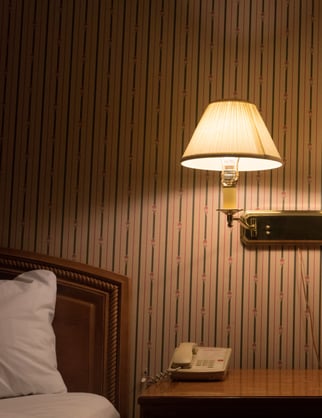
While being a standard component for any property, lighting is one of the most substantial aspects of a hotel’s design. Hotel lighting can indeed “make or break” a space.
Common Hotel Lighting Mistakes
The right lighting can completely change the mood of a room and impact guest experience simultaneously. Making sure your lighting fixtures are not only well-designed but also provide sufficient brightness is key to accommodating both guest and staff needs.
Though lighting may seem like an easy concept to understand, there are many ways that it can go wrong. Here are some of the most common hotel lighting mistakes hotel managers make and tips on how to fix them:
Lack of Lighting Variation
A frequent lighting mistake is only selecting one type of fixture to light up a whole room. Too little or too much light can make guests feel extremely uncomfortable. To fully light up a space, hoteliers need to incorporate three main lighting types to create “layers of light”: Ambient, Task, and Accent.
Ambient lighting is the general lighting basis for the whole room, (such as overhead lights) and is the most essential type of light for any space. It is usually provided by one or two central ceiling lights or possibly wall lights and should account for around 75% of a room’s light. Unfortunately, this is often where many hoteliers stop. Whilst ambient light is sufficient for basic activities it is not suitable for task-based activities such as reading, shaving, or applying make-up. Accent lighting comes in the form of table lamps and sconces. Relying on overhead lighting alone won’t light up an area entirely. As a result, the walls would appear dark. Accents are necessary to wash light over vertical spaces so that the room’s walls are adequately lit.
Accent lighting comes in the form of table lamps and sconces. Relying on overhead lighting alone won’t light up an area entirely. As a result, the walls would appear dark. Accents are necessary to wash light over vertical spaces so that the room’s walls are adequately lit.
Task lighting is self-explanatory: tasked based lighting that focuses on specific areas. Some examples of task lighting include bedside table lamps used for reading and writing, over bed wall reading lights, desk lamps and directional floor lamps. Bathrooms also benefit from task lighting but so many people simply rely on a single central light fitting. Overhead lighting can cast shadows so, if possible, try adding wall lights either side of a mirror to assist with shaving and applying make-up. Task lighting is a necessary addition for guest convenience and comfort.
Incorrect Type of Lighting
Just as each room in a hotel serves a different purpose, lighting for individual spaces should as well. One thing to consider is how bright a location needs to be in order to serve its main purpose. For example, a hotel lobby must have sufficient lighting for hotel staff to efficiently complete tasks like guest check-ins and other administrative duties, or a bathroom needing efficient lighting for guests to properly see and groom themselves. However, in lower activity areas like hallways and corridors, you would want less intense, more ambient lighting. You may run the risk of either over lighting or under lighting a space if you do not choose the correct lumens based on the ambiance you wish to create.

Disregarding Sizing Needs
Size is another commonly overlooked aspect when choosing lighting for rooms. A particular lighting design may seem trendy or looks good within a hotel room, but it’s just not the right size for your space. Fixtures that are too small can seem underwhelming or even cheapen a space, while oversized fixtures loom over a room and take the attention from anything else.
You will need the scale of your lights to be proportional to the area and its size, which heavily affects both design and function. Poor sizing design choice might mean selecting overhead lights that are too short for the room’s height, for instance. Improper sizing will influence an area’s brightness, mainly if you choose a fixture that is too small to light up the whole space. Factoring in both design and functionality when determining the size of your light fixtures is important.
Not Customizing Your Selected Lighting
Lighting is never a one-size-fits-all solution. Every fixture and bulb have to be treated individually, even if they are in the same room. Each light requires a separate switch and dimmer for individual control. Your lighting should change throughout the day, as well. You don’t want the same level of brightness for day and night. Customize automatic settings, so your lights adjust according to the time of day to provide guests with the best ambiance at all times.
Placement Tips
Improved lighting serves to enhance the guestroom experience and provide a sense of security. For example, the following techniques should to implemented whenever possible:
- A lamp for the desk
- One between chairs in the seating area
- Reading lights at bed that are individually controlled
- Closet light that turns on automatically when door is opened
- Entrance/exit lighting
- Ample bathroom lighting
- Dimmer switches on each light source

